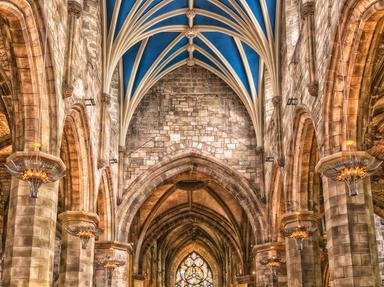Quiz Answer Key and Fun Facts
1. Known as 'Piazza dei Miracoli' ("Square of Miracles" in English), the cathedral pictured here, with its separate baptistery in the foreground, is one of the finest architectural complexes in the world. In which Italian city is it located?
2. A UNESCO World Heritage Site since 2000, the 440-foot long, five-towered "Cathedral of Our Lady", also known as 'Notre-Dame de Tournai', is located in which European country?
3. Built of red sandstone, the "Cathedral of St Peter" has four round towers, two large domes, and a choir at each end and today is designated as a 'basilica minor'. The cathedral pictured is located in which German town on the River Rhine that will always be associated with Martin Luther?
4. St. Stephen's Basilica is named after the country's first king, who reigned from 1000 to 1038. Completed in Neoclassical style in 1905, it is the country's most important church building as well as one of its most significant tourist attractions. In which European capital can you visit the pictured cathedral?
5. Built between 1070 and 1300, Nidaros Cathedral is the world's most northerly medieval cathedral. It was built over the burial site of Saint Olaf, the 11th-Century king who would later be adopted as the country's patron saint. In which European country can you visit the pictured cathedral?
6. A religious site has stood here since 930 and the current structure dates back to the 14th Century. Burial site of many Bohemian kings and Holy Roman Emperors, the "Metropolitan Cathedral of Saints Vitus, Wenceslaus and Adalbert" (pictured) dominates the skyline of which European capital?
7. Constructed between 1220 and 1270 and designated as a UNESCO World Heritage Site in 1981, the pictured cathedral stands on a ridge overlooking the River Somme. With an internal height of 139 feet, it is the tallest completed cathedral in France and also has the largest internal volume. In which French city can you visit the pictured cathedral?
8. Built in the Gothic style in the 1220s, Renaissance additions were made to the pictured cathedral in the 15th and 16th centuries. Famous for its vast size and unique architecture, this is the only Spanish cathedral that is designated as a UNESCO World Heritage Site without also being joined with the city's historic center or with other buildings. In which Spanish city can you visit the pictured cathedral?
9. "The Abbey of Saint Gall", a Carolingian-era abbey that has existed since 719, became an independent principality during the 13th century and was for many centuries one of the chief Benedictine abbeys in Europe. Today it houses one of the world's richest medieval libraries. Designated a UNESCO World Heritage Site in 1983, in which country can you visit the pictured cathedral?
10. Notable for its Neo-Classical style (resembling a Greek temple) with a detached Baroque bell tower, the pictured cathedral represents the heart of the country's Catholic spiritual life. It is dedicated to two saints, Stanislaus of Szczepanów, the Bishop of Krakow martyred by King Bolesław II the Bold of Poland in 1079, and Ladislaus I, King of Hungary from 1077 and of Croatia from 1091 until his death in 1095. In which European capital is the pictured cathedral located?
Source: Author
EnglishJedi
This quiz was reviewed by FunTrivia editor
stedman before going online.
Any errors found in FunTrivia content are routinely corrected through our feedback system.


